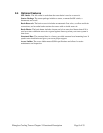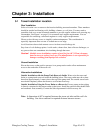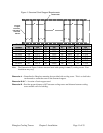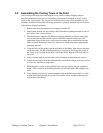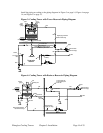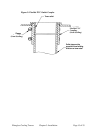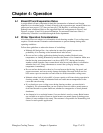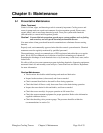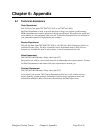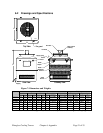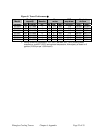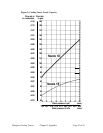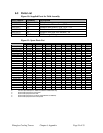
Fiberglass Cooling Towers Chapter 4: Operation Page 17 of 25
Chapter 4: Operation
4-1 Bleed-Off and Evaporation Rates
A proper bleed-off rate is important to limit the concentration of minerals and foreign
materials in re-circulated water. A bleed-off equal to the evaporation rate, normally about two
gallons per hour per ton (7.57 liters per hour per 3,780 Kcal/hr), is sufficient for many
makeup water conditions. Refer to the suggested bleed-off arrangements in Figure 3 and
Figure 4 on pages 14 and 14 for more information. For automatic bleed rate control, a
conductivity controller is available through the Sales department.
4-2 Winter Operation Considerations
All cooling towers are subject to ice formation in sub-freezing weather. Your cooling tower
requires a certain amount of attention and maintenance to prevent damage during these
operating conditions.
Follow these guidelines to reduce the chance of ice buildup:
• Maintain full design flow. Any reduction in water flow greatly increases the
probability of ice forming on and around the air inlet louvers.
• Do not use free cooling applications during freezing weather. Reduced water
temperatures or loading dramatically increases the chance of ice formation. Make sure
that the leaving water temperature is set above 80ºF (27ºC) during sub-freezing
weather so heat from the water warms the air inlet louvers and reduces ice formation
when the fan is off. Using a thermostat to control fan cycling by leaving water
temperature is mandatory.
• Do not run fans backward to thaw ice. Ice can form on the fan ring, fan guard, and
support structures, and can severely damage fan blades. Reversed airflow can also
blow water vapor out onto the roof and create ice fields around the cooling tower.
• Maintain a heat load of at least 60% of tower capacity at all times during operation in
freezing weather. A lack of substantial load can create uneven temperatures in the
tower and cause freezing.
• If you shut down your cooling tower during freezing weather, you must drain it
completely. We recommend that you use an indoor reservoir tank to permit water to
drain into the tank on system shutdown, whether for emergencies or actual planned
shutdowns.
• An alternative is to use basin heaters if a tower basin is used as a sump. Basin heaters
are available as an option. However, basin heaters can permit freeze-up during power
failures if water remains in the sump. The customer is responsible for determining risk
factors for each specific application.



